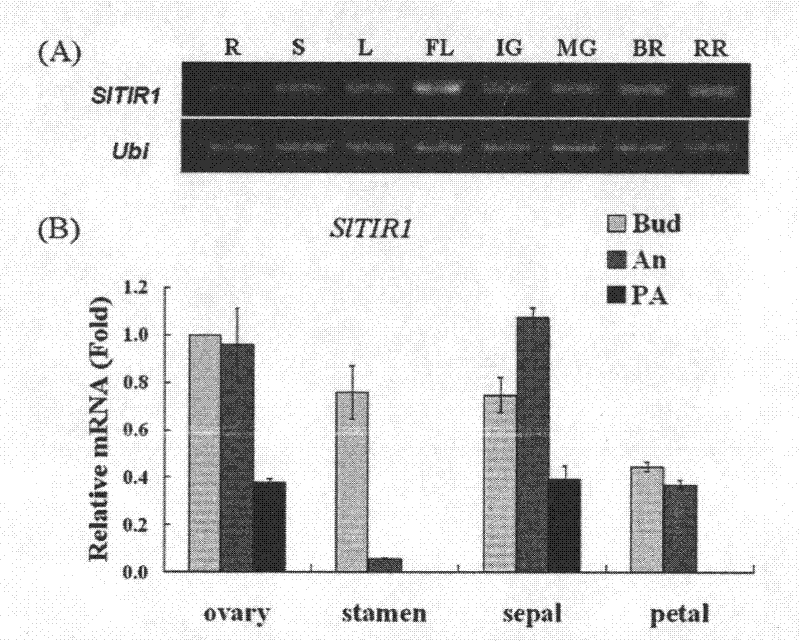Application of tomato growth hormone receptor homologous gene S1TIR1 in fruit parthenocarpy
A homologous gene, parthenocarpic technology, applied in application, genetic engineering, plant genetic improvement, etc., can solve problems such as affecting crop yield and crop failure to pollinate successfully.
- Summary
- Abstract
- Description
- Claims
- Application Information
AI Technical Summary
Problems solved by technology
Method used
Image
Examples
Embodiment 1
[0026] Embodiment 1: tomato SlTIR1 gene cDNA clone
[0027] The comparison and analysis of the tomato EST database showed that the EST sequence (SGN-U327259) had a high homology with the Arabidopsis AtTIR1 sequence. The comparison of the nucleotide sequences of SGN-U327259 and AtTIR1 showed that the EST already contained the 5' end DNA sequence. Therefore, this EST was selected for cloning the auxin receptor homologous gene cDNA. According to the EST sequence, we designed a sequence-specific primer P1: 5'-GAAGCCTCATTTTGCTGATTTCA-3' (SEQ ID NO: 4). Total RNA was extracted from tomato (Micro-Tom) seedlings using the TRIZOL (invitrogen, USA) method, and 2 μg of total RNA was used to prepare cDNA using the Fermentas Reverse Transcription Kit (Fermentas, UK). The entire operation was performed according to the kit instructions.
[0028] According to the instructions of the 3’-Full Race Core kit, the P1 primer and the other three primers in the kit were used to amplify the cDNA 3’...
Embodiment 2
[0029] Embodiment 2: Obtaining of the complete sequence of tomato SlTIR1 gene
[0030] The obtained cDNA sequence was compared with the tomato database (SGN) to obtain the complete sequence of the tomato SlTIR1 gene. The gene consists of 3849 deoxyribonucleotides (see sequence 1 in the sequence listing). The SlTIR1 genome starts from the 5' start codon ATG to the 3' stop codon TAG, with a total length of 3849 nucleotides, including 3 exons and 2 introns. The structure of the SlTIR1 gene (see figure 1 ).
Embodiment 3
[0031] Embodiment 3: Expression analysis of SlTIR1 gene in different tissues of plants
[0032] Materials from different tissues of tomato (root, stem, leaf, flower, immature green fruit, ripe green fruit, color-breaking fruit, ripe fruit) were used for semi-quantitative analysis. The analysis results showed that SlTIR1 was highly expressed in flowers, indicating that SlTIR1 may play an important role in the development of floral organs. In order to further study the role of SlTIR1 in the development of floral organs, we used materials from different parts of floral organs at different stages (sepals, stamens, pistils, and ovary 1 day before flowering; sepals, stamens, pistil, and ovary before flowering; 4 days after flowering). days) for quantitative analysis. Quantitative PCR results showed that the expression level of SlTIR1 increased in sepals and decreased significantly in stamens from before flowering to flowering stage. From the flowering period to 4 days after flower...
PUM
 Login to View More
Login to View More Abstract
Description
Claims
Application Information
 Login to View More
Login to View More - R&D
- Intellectual Property
- Life Sciences
- Materials
- Tech Scout
- Unparalleled Data Quality
- Higher Quality Content
- 60% Fewer Hallucinations
Browse by: Latest US Patents, China's latest patents, Technical Efficacy Thesaurus, Application Domain, Technology Topic, Popular Technical Reports.
© 2025 PatSnap. All rights reserved.Legal|Privacy policy|Modern Slavery Act Transparency Statement|Sitemap|About US| Contact US: help@patsnap.com



